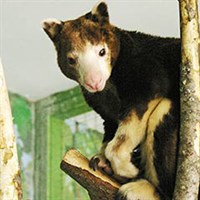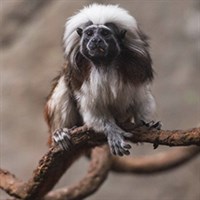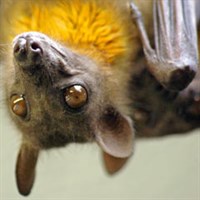Stone Zoo welcomes a number of new furry faces
Tuesday July 1, 2014
Visitors to Stone Zoo will notice several new faces this summer with the addition of a number of new species including a male Matschie’s tree kangaroo, six cotton-top tamarins and straw-colored fruit bats.
All of the new additions can be seen in the newly renovated Windows to the Wild exhibit space, which is also home to Caribbean flamingos, prehensile-tailed porcupines, Inca terns, hyacinth macaws, red-rumped agouti and Central American agouti.
“We are excited to highlight these new species at Stone Zoo. Guests will delight in visiting with these fascinating new additions and learning more about their natural history and unique adaptations,” said John Linehan, President and CEO of Zoo New England, who added, “After such a long winter, we’re thrilled to present a robust offering of programs and experiences at Stone Zoo this summer and we hope that people will discover all that the Zoo has to offer, including visiting with some of the newest additions to the animal family.”
 These endangered animals are native to the Huon Peninsula in northeastern Papua New Guinea where they can live in elevations up to 6,562 feet. Primarily arboreal, tree kangaroos climb by wrapping their forelimbs around tree branches and hopping with their hind legs, which allows their arms to slide up the branch. Matschie’s tree kangaroos are well adapted for life in the trees and are able to leap almost 60 feet down to the ground. These marsupials have reddish brown fur with light tan or yellow fur on their stomach, feet, tail and the edges of their ears. In the past, Zoo New England has supported a large scale conservation project in their native range that works with the indigenous people to preserve this unique species and the tropical forests they inhabit.
These endangered animals are native to the Huon Peninsula in northeastern Papua New Guinea where they can live in elevations up to 6,562 feet. Primarily arboreal, tree kangaroos climb by wrapping their forelimbs around tree branches and hopping with their hind legs, which allows their arms to slide up the branch. Matschie’s tree kangaroos are well adapted for life in the trees and are able to leap almost 60 feet down to the ground. These marsupials have reddish brown fur with light tan or yellow fur on their stomach, feet, tail and the edges of their ears. In the past, Zoo New England has supported a large scale conservation project in their native range that works with the indigenous people to preserve this unique species and the tropical forests they inhabit.
 Cotton-top tamarins are a small, but striking, endangered monkey native to the tropical forest of northwestern Colombia. Cotton-top tamarins have a monogamous mating system and live in groups numbering up to 19 individuals. Groups consist of a dominant mated pair, their young and few subordinate adults or young. These small primates, which are about the size of a squirrel, have a long white crest of hair stemming from the forehead to the nape and flowing over their shoulders. Zoo New England has supported field work and education efforts in Colombia to preserve cotton-top tamarins.
Cotton-top tamarins are a small, but striking, endangered monkey native to the tropical forest of northwestern Colombia. Cotton-top tamarins have a monogamous mating system and live in groups numbering up to 19 individuals. Groups consist of a dominant mated pair, their young and few subordinate adults or young. These small primates, which are about the size of a squirrel, have a long white crest of hair stemming from the forehead to the nape and flowing over their shoulders. Zoo New England has supported field work and education efforts in Colombia to preserve cotton-top tamarins.
 Straw-colored fruit bats are native to the forests and savannahs of sub-Saharan Africa. These nocturnal animals have long tapered wings measuring up to 3 feet, which allow them to fly long distances. In fact, they have even been found 125 miles out to sea. Because straw-colored fruit bats feed on nectar and blossoms, they play an important role in pollination. They also serve as agents in seed dispersal – in effect planting seeds for future harvest.
Straw-colored fruit bats are native to the forests and savannahs of sub-Saharan Africa. These nocturnal animals have long tapered wings measuring up to 3 feet, which allow them to fly long distances. In fact, they have even been found 125 miles out to sea. Because straw-colored fruit bats feed on nectar and blossoms, they play an important role in pollination. They also serve as agents in seed dispersal – in effect planting seeds for future harvest.
In addition to the new faces in the Windows to the Wild exhibit space, a new American alligator exhibit debuted at Stone Zoo at the end of May. The exhibit, located within the Alfred Huang North American Crane Exhibit is home to three gators ranging in length from 5 to 7 feet. Guests are invited to learn more about the gators at the daily education encounters at 10:30 a.m. and 2:30 p.m. (weather permitting), where they can see a young gator, measuring 1 foot long, up close.
Photo credits:
Matschie's tree kangaroo: Zoo New England/Dayle Sullivan-Taylor
Cotton-top tamarin: Eric Kilby
Straw-colored fruit bat: Zoo New England/Dayle Sullivan-Taylor

